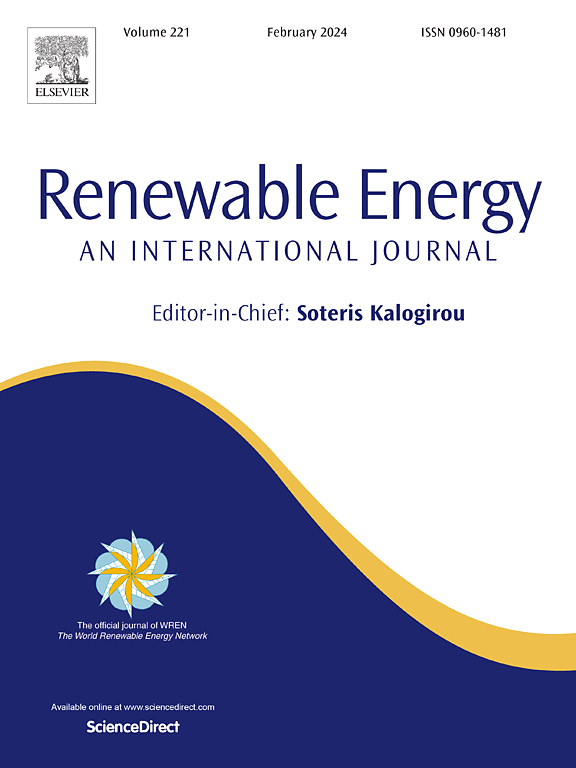台风-波-流耦合作用下风波共产结构体系失稳机理及判据
IF 9
1区 工程技术
Q1 ENERGY & FUELS
引用次数: 0
摘要
深海环境复杂多变,风波共产结构系统在台风-波-流极端耦合环境下容易发生剧烈振荡或大位移,甚至发生倾覆失稳,而现有研究忽略了极端环境下风波共产结构系统的失稳过程和内在机制。本研究提出了一种将半潜式风力机与升天型波浪能转换器集成的新型风浪热电联产结构体系,结合中尺度WRF-SWAN-FVCOM (W-S-F)耦合模拟方法,对台风“拉玛逊”进行了风浪流耦合精细化模拟,建立了风浪流多层耦合速度场模型。基于中/小尺度嵌套方法,进行了小型CFD数值槽试验,对比分析了不同海况下风浪热电联产结构系统的非线性振动响应规律。结合增量动力分析方法,研究了风浪热电联产系统的临界失稳风速,揭示了风浪热电联产系统在极端海洋环境下的失稳机理,建立了风浪热电联产系统的失稳判据。研究表明,随着风浪电流环境荷载的逐渐增大,风浪热电联产结构体系最终会因俯仰过大而发生倾覆失稳,其临界失稳风速为79 m/s。当风浪热电联产结构体系的俯仰角大于11.6°时,结构将发生俯仰失稳。本研究可为该类海上风浪热电联产结构体系的稳定性设计与优化提供工程参考依据。本文章由计算机程序翻译,如有差异,请以英文原文为准。
Instability mechanism and criterion of wind-wave co-generation structural system under typhoon-wave-current coupled action
The deep and remote ocean environment is complex and variable, the wind-wave co-generation structural system is prone to violent oscillations or large displacements under the extreme coupled environment of typhoon-wave-current, and even to capsize instability, while the existing researches have neglected the instability process and the intrinsic mechanism of the wind-wave co-generation structural system under the extreme environment. In this study, a novel wind-wave co-generation structural system is proposed by integrating the semi-submersible wind turbine and the heave-type wave energy converter, the refined simulation of wind-wave-current coupled for Typhoon Rammasun is carried out by combining mesoscale WRF-SWAN-FVCOM (W-S-F) coupled simulation method, and a wind-wave-current multi-layer coupled velocity field model is established. Based on the meso/small-scale nested method, a small-scale CFD numerical tank test is conducted to comparatively analyse the nonlinear vibration response rules of the wind-wave co-generation structural system under different sea conditions. Furthermore, the critical instability wind speed of the wind-wave co-generation system is investigated by combining with the incremental dynamic analysis method, the instability mechanism of the wind-wave co-generation system under extreme marine environment is revealed, and the instability criterion is established. The study demonstrates that the wind-wave co-generation structural system will eventually capsize instability due to excessive pitch with the gradual increase of the wind-wave current environmental load, and the critical instability wind speed is 79 m/s. When the pitch angle of the wind-wave co-generation structural system is greater than 11.6°, the structure will undergo pitch instability. This study can provide engineering reference basis for the stability design and optimisation of this kind of offshore wind-wave co-generation structural system.
求助全文
通过发布文献求助,成功后即可免费获取论文全文。
去求助
来源期刊

Renewable Energy
工程技术-能源与燃料
CiteScore
18.40
自引率
9.20%
发文量
1955
审稿时长
6.6 months
期刊介绍:
Renewable Energy journal is dedicated to advancing knowledge and disseminating insights on various topics and technologies within renewable energy systems and components. Our mission is to support researchers, engineers, economists, manufacturers, NGOs, associations, and societies in staying updated on new developments in their respective fields and applying alternative energy solutions to current practices.
As an international, multidisciplinary journal in renewable energy engineering and research, we strive to be a premier peer-reviewed platform and a trusted source of original research and reviews in the field of renewable energy. Join us in our endeavor to drive innovation and progress in sustainable energy solutions.
 求助内容:
求助内容: 应助结果提醒方式:
应助结果提醒方式:


